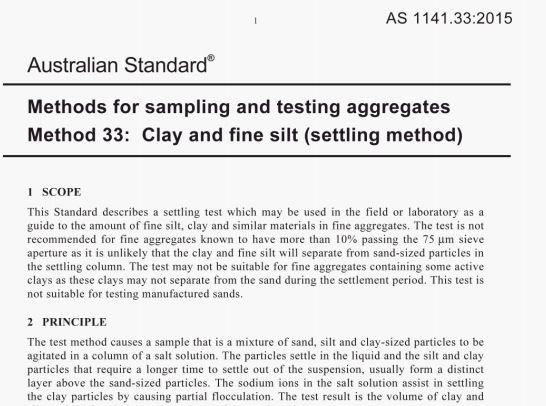AS 1141.33:2015 pdf – Methods for sampling and testing aggregates Method 33: Clay and fine silt (settling method).
The following apparatus, complying with the requirements below and those of AS 1141.2 are required:
(a) Balance’—having a limit of performance of ±0.5 g.
(b) C)Iinder—of glass or transparent plastic, graduated to 250 mL in 2 mL increments. The cylinder shall be stoppered to prevent loss of sample and test fluid when the cylinder is shaken and inverted during testing.
6 REAGENT
The reagent shall be common salt or table salt.
7 TEST PORTION
The test portion shall be representative of a sample obtained in accordance with AS 1141.3.1. The portion obtained shall be sufficient to yield about 100 mL of fine aggregate from the sample. This test portion shall be used without drying or any other treatment.
8 PROCEDURE
The procedure shall be as follows:
(a) Prepare a nominal 1% solution of common salt in water by adding lOg of common or table salt to I L of water.
(b) Place about 50 mL of the salt solution in the 250 mL measuring cylinder. Pour aggregate into the cylinder until its measured volume in the cylinder is approximately 100 mL. If the volume of the aggregate and liquid is less than 150 mL, make the volume up to 150 mL by the addition of more salt solution and stopper the cylinder.
(c) Shake the mixture vigorously for approximately 30 s until adherent particles have been dispersed. Place the measuring cylinder on a level surface, and gently tap it until the surface of the aggregate is level.
(d) Allow the measuring cylinder and contents to stand for 180 +10, —0 minutes. At the end of that time carefully examine the sand layer to determine if clay and silt particles are clearly visible, trapped between the sand particles. If the separation of the clay and silt from the sand has not occurred, report the result as indeterminate’.
NOTli: For quality control purposes at individual sites, it may be possible to obtain a result by reducing the quantity of sample in Item (b) above to 50 mL instead of 100 mL, but tilling the cylinder with the liquid to 150 mL. This may result in better separation of the silt and clay. However, as the relationship between results so obtained and results from this Standard are unknown, any results obtained should be reported as Non-standard’.
(e) If a clear separation of the silt and clay from the sand is obtained, record the volume of the sand (S) and the volume of the settled clay and fine silt (F), in millimetres (see Figure I).
NOTli: When using a measuring cylinder, reading the heights in millilitres is sufficient as ihe cross-sectional area of the cylinder is the same at any height and therefore the ratio of the layer volumes is equivalent to the ratio of the layer heights.
AS 1141.33:2015 pdf – Methods for sampling and testing aggregates Method 33: Clay and fine silt (settling method)
